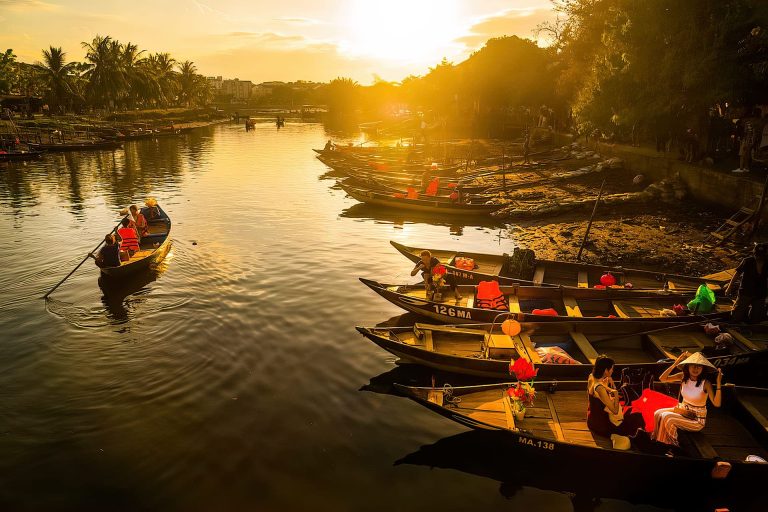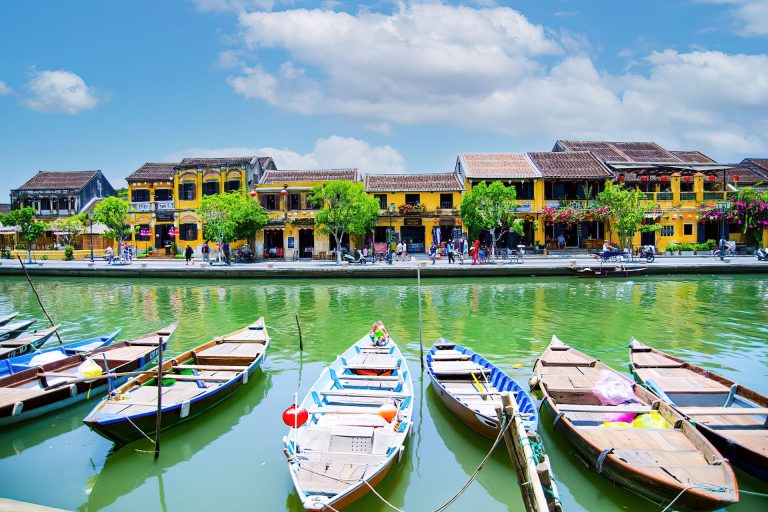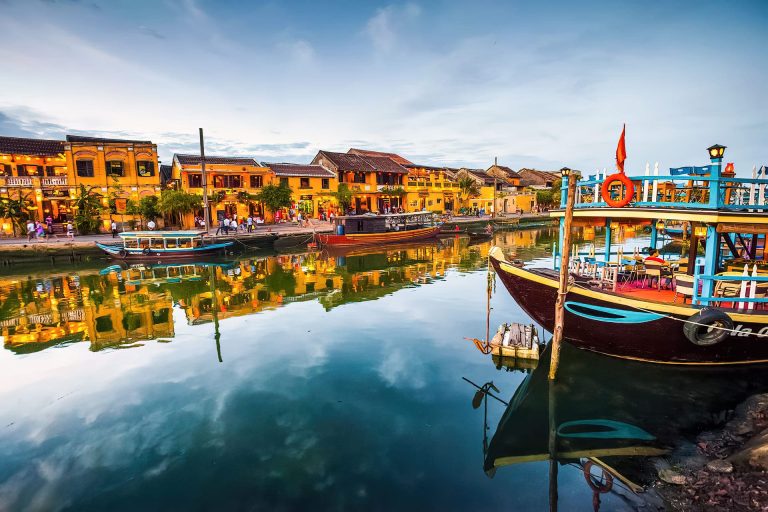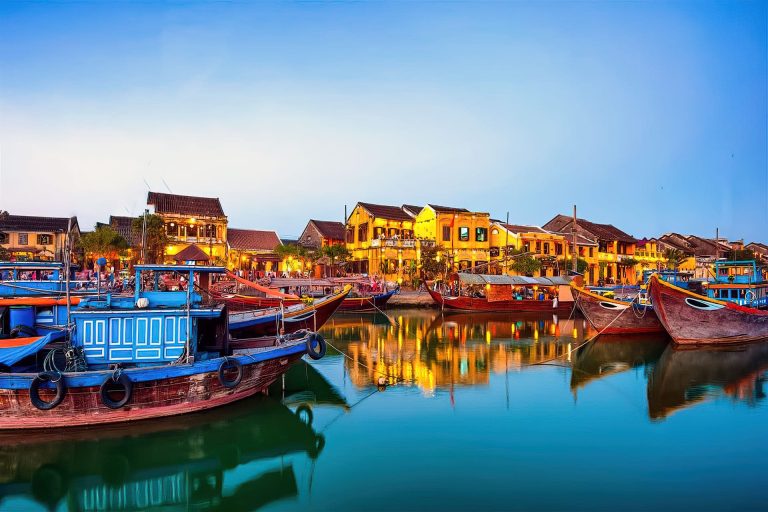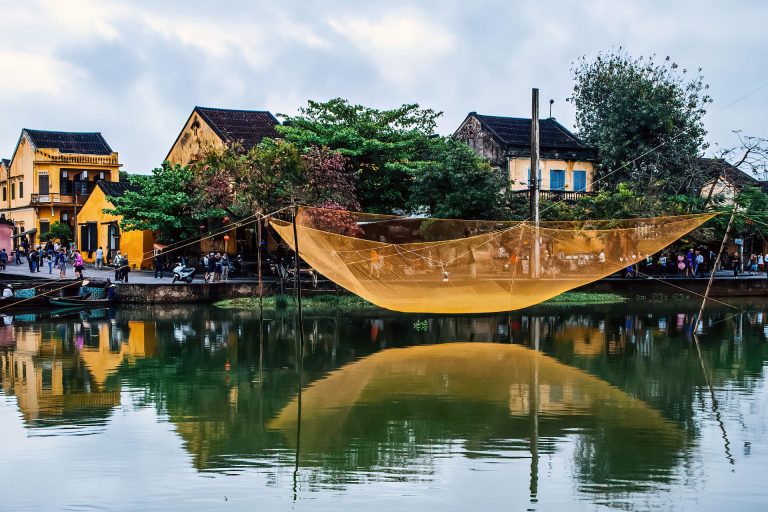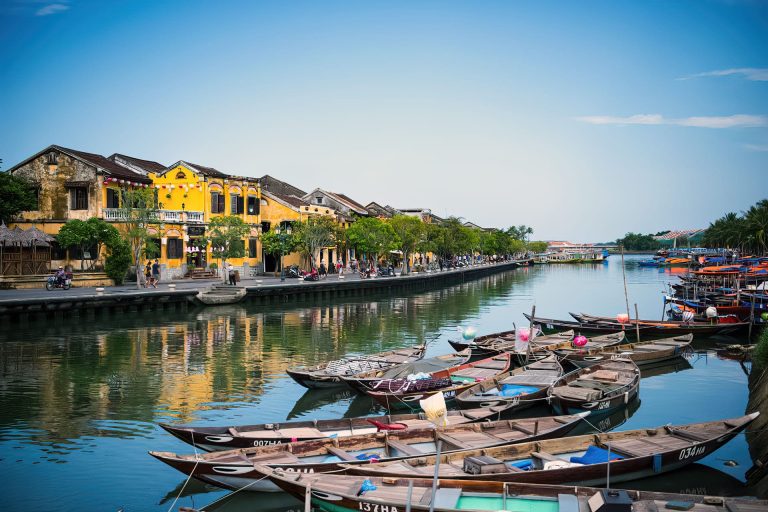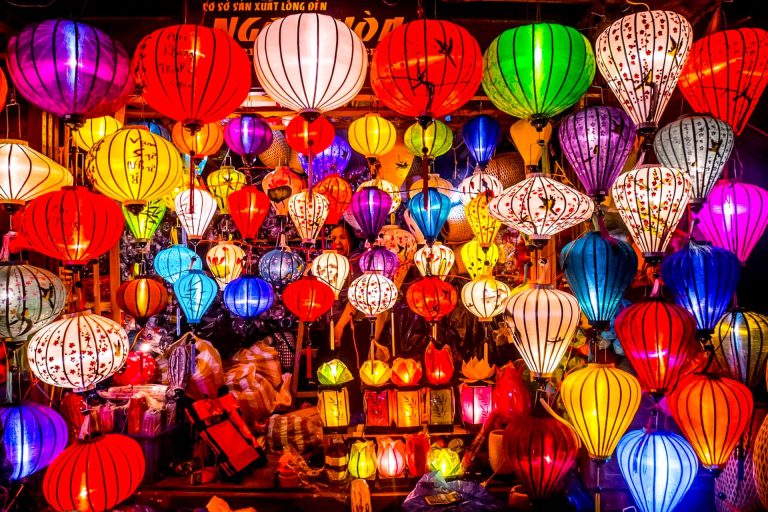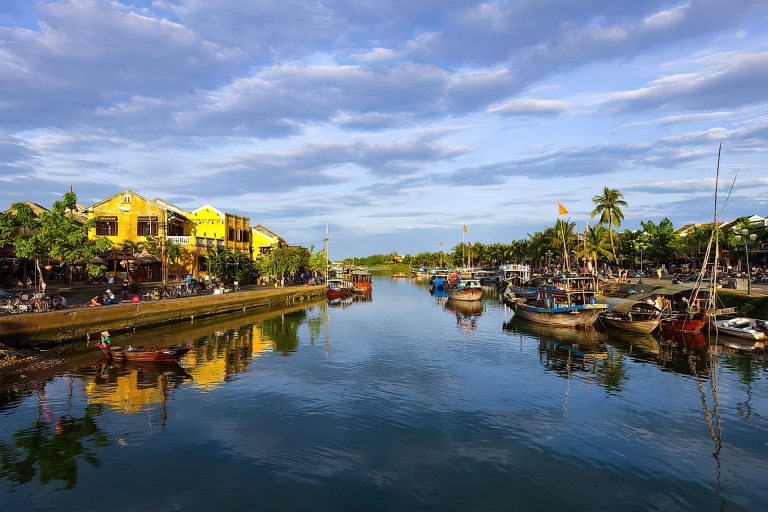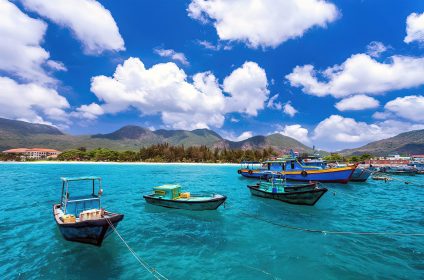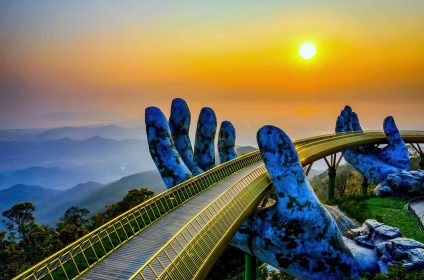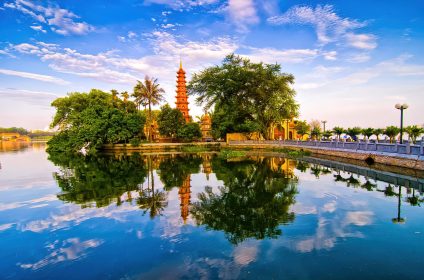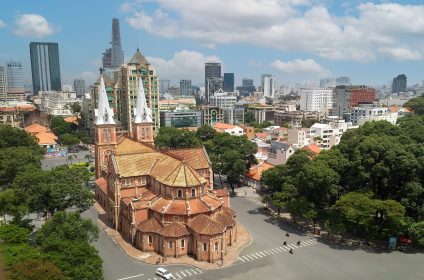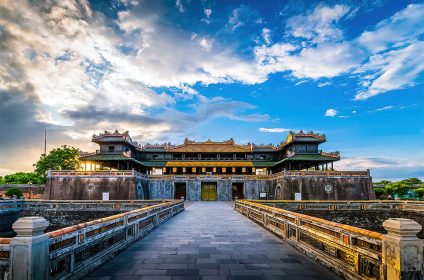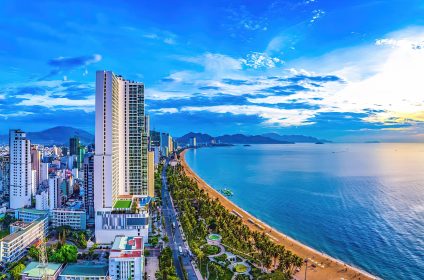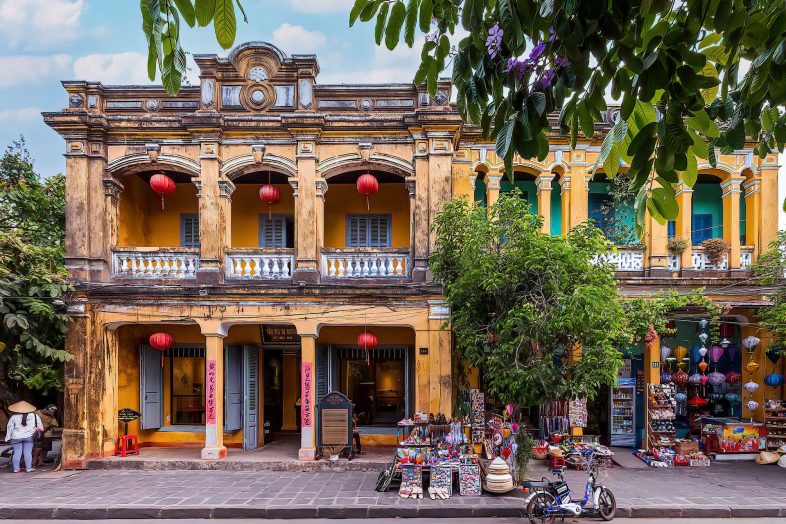
Attractions & Things To See In Hoi An
Must See Attractions In Hoi An
Japanese Bridge
The Japanese Bridge, which is also known as “Chua Cau” in Vietnamese, has always been the symbol of this sleepy harbor city- Hoi An. It is well-known for its ethereal curves and Zen-like design.
Legend has it that this bridge was built to protect people from the monster called Mamazu that caused a lot of disasters. In reality, it was constructed by a Japanese trading community in 1593 to connect them with Chinese settlement across a tiny stream. It remains an amazing destination today and an awesome reminder of Japanese influence on Vietnam.
Hoi An’s Old Quarter links Nguyen Thi Minh Khai St. and Tran Phu St through this almost 20-meter bridge, which overlooks the peaceful Thu Bon River.
Two statues of these animals have been put up at each end because its construction began in 1593 during the year of the monkey and ended in 1595 during the year of dog. They speak for those who guard the bridge.
The low entrance to Japanese Bridge is where visitors can best appreciate the fancy decoration on it. Within there might be quite dark but look at those little china jars ending tile ridges out there! On top of the creek, just north of that little temple stands one humble shrine. There are also some interesting galleries at one other end where you can find many tourists too.
This is such a place that has got wonderful historical background and astonishing red fading color which no photographers would ignore; moreover, it looks more delicate at night due to being lighted up by lamp posts.
- Entrance: Free
- Distance to city center: 1.4km (0.9 mi)
The Tran Family Chapel
The Tran Family Chapel, as it is not just another family’s place of worship, but a significant historical site in the popular Hoi An area.
There isn’t one person who can say for sure the exact location in Hoi An that is old and lovely but many people know about the oldest and most historical houses in this city which include Tran Family Chapel built by Tran Tu Nhac – a very revered mandarin during Gia Long Reign when they were still royal envoys to China. It was originally used as a shrine for worshipping their ancestors, and also as an educational device meant to pass on knowledge to subsequent generations concerning their family customs. Nowadays, visitors can find this famous destination at 21 Le Loi Street within the ancient quarter of Hoi An
A combination of Chinese, Vietnamese, and Japanese architectural styles that has remained virtually unchanged since two centuries ago is surrounded by a 1500 m2 garden full of ornamental plants , flowers , fruit trees and centaury-old plants . A gate and high walls enclose the garden. Known for its Oriental style, this house is constructed from precious woods with pan-tiled roofing. There are two major sections – one for worshiping purposes while the other serves the patriarch of the family together with his guests. The house was made simultaneously with its garden both observing strict Feng Shui principles. According to old traditions men came through another door located on left side while women would enter from right hand side into drawing-rooms of chapel. There is yet another entrance through which important activities like Tet celebrations are held—between these two doors; people believe that it represents gateway for souls of ancestors.
Every year at least once all relatives come together at Tran Family Chapel to express gratitude towards forefathers’ wisdoms as well as parenting role among other things.
For those tourists who love ancient places with unique atmosphere combining history and tradition preserved not only in swords or seals belonged to Tran Tu Nhac but also in every room of the house, old family photos, and in the cozy atmosphere of a family reunion, the Tran Family Chapel will be a lasting memory in Hoi An.
- Entrance: Free
- Hours: 8:30 AM to 6:00 PM
- Distance to city center: 1.1km (0.7 mi)
Fujian Assembly Hall
Among other places of worship in Hoi An, the Fukien Assembly Hall is one of five popular assembly halls that was created as a gathering place and a temple for the people of ethnic Chinese origin from China’s Fujian province around 1690.
Built circa 1690, the Phuc Kien (Fujian) Assembly Hall originally served as an assembly hall for Fujian Chinese. However, it became a temple dedicated to Thien Hau, the goddess of seafarer who rescues sailors from danger. It is believed that the Chinese decided to construct this temple because they wanted to worship their sea goddess statue found on Hoi An Beach about 10 years earlier. The Fujian Assembly Hall today shares its address with its neighbor at 46 Tran Phu St. which is one among those five assembly halls located in the town.
Fujian Assembly Hall has all the typical architectural features of a Chinese assembly hall. The pagoda looks very beautiful with its elaborate gate and colorful courtyard decorated by fountains. Here there are shrines and numerous finely carved dragons in total occupying most space. They have positioned representations below the central altar: gods of etiquette, fertility goddesses, three fairy ladies and twelve maidservants who educate infants how to smile or suckle et cetera; hence barren couples frequently visit this sanctuary to pray for children.
Many murals, lacquer boards, paintings and other works within this shrine tell not only about worshiping Tibor’s but also reveal some other important deities venerated by Fujianese people. A lot of statues together with bronze bells can be found although out Buddhist temples as well as drums and vertical lacquered boards that have been engraved with Chinese characters are available inside these temples too. This implies overall arrangement and combination of elements if observed gives an idea concerning what Chinese would call pleasure.
Due to various events held here each year during major Chinese festivals, the Fukien Assembly Hall is now a favorite attraction for tourists across Vietnam.
- Entrance: Free
- Hours: 8AM – 5PM
- Distance to city center: 0.7km (0.4 mi)
Assembly Halls in Hoi An
For the reason that it was an important trading port in the past, many meeting halls have been established as gathering places for old traders.
When Chinese moved or did business abroad, they would usually build a Hall of Assembly, so that they could make new friends and pass on their traditions to future generations. Consequently, Vietnam has plenty of such kinds of Assembly Halls today. Hoi An Town has five other Chinese assembly halls that were built during its history of foreign trade.These are all found along Tran Phu Street and face Thu Bon River. Though not all these halls have remained unchanged over time, there are five that have become famous tourist spots in Hoi An.
In general, they stick with the pattern followed by other Chinese assembly houses in other towns: a grand gate to enter through; a beautiful garden filled with ornamental plants and flowers; one central hall; and an altar area. All decorations inside the building are important elements of any assembly hall because they may include various sculptures, lacquered boards, paintings and others. On the other hand, worshiping different gods is what distinguishes between various assemblies within China’s immigrant communities.
Fujian Assembly Hall is among the largest known assembly halls out of dozens located in Hoi An Town which number five. This is at 46 Tran Phu St.
The oldest is Ngu Bang Assembly Hall (Trung Hoa Assembly Hall), which now stands at 64 Tran Phu St. It honors Goddess Thien Hau.
Ghaozhou Hall (Trieu Chau), also known as Am Ban Pagoda or Ong Bon is adjacent to Fujian Assembly Hall at 157 Nguyen Duy Hieu Street. The place worships General Phuc Ba who controls water (or Bon Dau Quan).
Quang Dong Cantonese Assembly Hall can be found on 176 Tran Phu Street. It was created in 1885 and had a beautiful courtyard with sculptures.
There are services in Hainan Assembly Hall which is situated at 10 Tran Phu St. for these 108 Chinese merchants who were mistakenly executed as pirates. Later, Tu Duc King declared them “deities” and financed the building of this assembly hall where devotees would congregate without fail.
- Entrance: Free
- Hours: 9AM – 4PM
- Distance to city center: 0.7km (0.4 mi)
My Son Sanctuary
The lovely red towers in My Son will undoubtedly fascinate you, if the vibrant lanterns lining the city’s streets at night do.
My Son Sanctuary is located at My Son village, Duy Tan commune, Duy Xuyen district, 30 km west of Tra Kieu (the former Cham capital) and about 69 km southwest of Da Nang City.
In size, My Son has seventy artistic works that range from small to large. It was the holly land of the Cham people from the fourth century to the thirteenth century. The culmination of Tra Kieu in the reign of King Bhadravarman in 4th century led to establishment of a religious centre for the royal family and members of nobility who resided in this sanctuary during major religious ceremonies. For nearly nine centuries, My Son developed into a Champa Kingdom with most significant ideas worshiping ancestral spirits as well as Hindu gods together with its class structure.
During fourth century, to worship Saint Siva Bhadravarman which indicates a combination of Saint Siva and then-King Bhadravarman name was given. Nevertheless, it was destroyed completely by fire during sixth century making it not possible for future generations to know how it really looked like. More temples were added over time by Cham Kings so that they could continue worshipping their gods and saints as well as to show their strength against other rivals’ invaders including Vietnam, China and Khmer until at the end of 13th C., when due to attacks by neighboring countries such as Vietnam, China and Khmer which forced them to shift their capital from here they had already been extensively damaged when they fought each other but later united against all outside foes such as Chinese or Vietnamese armies attacking on their motherland by moving inland across mountains into Truong Sanh area where there remained no strong fortifications except few islands inside rivers flowing through delta regions until eventually French arrived upon reaching Banh It and Luong Son temples near former Cham port city named Faifo in 1859.
My Son had been lost for centuries until 1898 when it was discovered by a French scholar and also visited from 1937-1944 by the Ecole Francaise d’Extreme Orient. However, during the war against America, this complex was heavily bombed so that today only 20 of the total number of 32 original fragments are still standing.
There were various architectural influences on My Son sanctuary according to many researchers who include French, Polish and Vietnamese such as Arabian, Malaysian and Indonesian especially Indian cultures. It is an amalgamation of different styles such as ancient style between the seventh and eighth centuries; Hoa Lai style from the eight to ninth century; Dong Duong from mid-ninth century or Middle period; My Son-Binh Dinh style. Each structure was created using sandstone or red bricks, which not many archaeologists even visitors know how they are made or constructed till now.
Though there isn’t much left nowadays of My Son Holly Land rich culture and arts at its heydays under Champa Kingdom rule, but it remains alive. This explains why in 1999 it received distinguished status as World Cultural Heritage Site, attracting millions people every year thus becoming one prestige place on earth that have a lot of traditions in itself annually.
- Entrance: 50,000VND
- Hours: 8AM – 4:30PM
- Distance to city center: 26.3km (16.3 mi)
Tra Que Herb Village
Hoi An got its name from the sweet-smelling vegetables used by the locals as spices in their daily meals.
Tra Que, a small village located three kilometers north of Hoi An’s old town, lies between the De Vong River and Tra Que algae pond. The village has always been known for growing many types of vegetables such as salad, lettuce, houttuynia, flagrant knoutwed and basil crops among many more because of fertile soils and abundant water that produces a unique condition for agriculture. This has led to fame of traditional dishes in Hoi An such as Tra Que herbs and vegetables including coriander.
Ordinary activities which are hardly seen in everyday life can make visitors to Tra Que Village amazed at how local farmers perform their farming practices: raking the earth; planting seeds; watering plants; gathering veggies, etc. Also, they can take part in farming activities done with hands or have lectures on organic cultivation processes. Rather than using chemical fertilizers this region employs a kind of algae which is only found in this lagoon to grow its crops. It has resulted to highest standard herbs and vegetables called Tra Que that are not toxic but tasty too.
Before lunching with friendly Vietnamese families enjoying Hoi An specialties like Cao lau noodles , Quang noddles , Bahn Xeo pancakes etc., it’s worth cycling through well-planned gardens featuring assorted patches of vegetables and flowers with their rich smells around you.
- Entrance: Free
- Hours: 7:30 – 17:00
- Distance to city center: 2.5km (1.6 mi)
Kim Bong Carpentry Village
To get more information about the traditional craftwork and culture of Hoi An, you should not forget about Kim Bong Village.
The village craftsmen from Nothern Vietnam have been making furniture and houses in many parts of the country since the 16th century. Among their notable works include; those found within the citadel and royal tombs in Hue, various famous structures in Hanoi, as well as most architectural jobs during Hoi An’s golden period were made by Kim Bong Carpentry in collaboration with China, Japan, Cham Kingdom and Vietnamese artisans.
Kim Bon village has rapidly grown for many years giving rise to three groups of artisans: shipbuilding, civil wooden furniture and antique architectural construction. Regardless which group they belong to; however, Kim Bon’s craftspeople still work traditionally starting as apprentices to becoming masters after many years.
Artists working on crafts using agile fingers can now be observed at Kim Bong Carpentry Village when taking a half-day biking tour. Vanilla gift shops may contain items such as religious charms or pitch-perfect wooden doors also manufactured by Kim Bong. They range from small religious monuments costing thousands of dollars to little coasters or trinkets. After all, a lot of contemporary residents are worried about historical buildings or relics, especially old houses located around Hoi An.
As you wander around the village streets but two parallel ones displaying low open-fronted structures will appear right before your eyes. Some of them are workplaces for craftspersons. One prominent shop is that belonging to Mr Huyn Ri who also demonstrates the use of traditional techniques in producing wood fishing boats.
- Entrance: Free
- Hours: 7:30 – 17:00
- Distance to city center: 2.8km (1.7 mi)
Old House of Tan Ky
Tan Ky Old House is a near-perfect exemplar of an 18th-century merchant’s home in this important port town and is located at No.101 Nguyen Thai Hoc Street, Old Quarter, Hoi An Ancient Town.
The name Tan Ky (Progress Shop) was given to the house by the second generation to show that they wanted their business venture to be successful.
This means that despite the fact that there have been several flood occurrences every year, and the economy of the town has also gone down, the family had kept this house intact for seven generations; thus making Tan Ky as one of the most preserved structures in Hoi An but certainly not its oldest.
The building remains unaltered in a number of respects such as storage area, exterior construction with bricks and tiles and recycled Bat Trang-bricked floor. How did it stay cool in summer while warm during winter? The answer lies in the use of jack-fruit trees, ironwood and peckwood for interior furniture as well as substantial roofs and wooden walls.
This includes features like bricks stored inside it ever since it was built which storeyed next to each other without change till today were made from Bat Trang village; therefore enabling its occupants to cope with humid weather during hot season. Planting this tree in a house would make your home cooler on sunny days. Porch beams which support clay Chinese roof-tiles are large enough above outside walls so as not let heat coming from sun penetrate into human living spaces. These boards running parallel from right to left express some thoughts of people who used them for writing after being engrained with parallel words. In this piece of work, letters are unexpected because each stands for a bird picture. One hundred birds mean perfectness.
- Entrance: Included in Hoi An pass
- Hours: 8:00 – 17:00
- Distance to city center: 1.2km (0.7 mi)
Hoi An Impression Theme Park
Long a major tourist destination in Vietnam, Da Nang – Hoi An offers a spectrum of attractions including white sandy beaches, ancient buildings, handicraft villages and parks for visitors. The beginning of this experience is an entry design reminiscing Thanh Chiem Citadel that shows the power and wealth of the Nguyen Dynasty.
It’s an incredible journey ahead as you get to enjoy the most hilarious history lesson ever.
With a total area of more than 10 hectares, Hoi An Impression Themed Park happens to be the first cultural theme park in Vietnam. It has managed to capture a big piece or Vietnamese history because it replicates almost all cultural aspects through traditional architectural designs, historical symbols and showing artisan communities.
The representation of five artesian communities- lantern making (earth), fishing (water), pottery (water) and copper working (metal) exemplifies this (fire). These five traditional villages have played pivotal roles in Quang Nam province’s history, economy and culture which have produced several carefully made goods by various creative local artisans.
- Entrance: 100,000
- Hours: 5pm-10pm
- Distance to city center: 0.7km (0.4 mi)
Old Town
While the Old Town is most likely its liveliest at night with activity along the riverside and silk lanterns diffusing a calming light, it also has historical architecture and streets which are full of stores and restaurants.
Old Town entrance fee is free but all historical sites follow a coupon system; for 120,000 won (2016), visitors can buy a five-attraction ticket. Tickets can be found at different entry points in the Old Town such as Hai Ba Trung Street or even at certain attractions like the Cantonese Assembly Hall.
Landmarks
- Japanese Covered Bridge (Chua Cau or Lai Vien Kieu) (At the west end of Tran Phu St). The bridge was built by the Japanese community in the early 1600s, around 40 years before they had to leave the city to return to Japan because of the severe sakoku policy imposed by the Tokugawa Shogunate. It was renovated in 1986. It serves as Hoi An’s emblem today. One voucher is required for entry, although you can cross back and forth repeatedly without running across a ticket-checker. If your morals worry you, consider leaving a gift for the statues of the pig and dog that stand watch at either end of the bridge, respectively.
- Quan Cong Temple, 24 Tran Phu St (near corner of Tran Phu and Tran Quy Cap). This shrine, which dates back to the 15th century, is devoted to the Chinese general Quan Cong, who is revered for his traits of loyalty, integrity, and justice. Inside the temple, there are statues of him and several other people.
- Thanh Ha pottery village. Formed in the sixteenth century, Thanh Ha Pottery Village is one of the oldest pottery villages in Vietnam. This village is located right on the banks of Thu Bon River, about 3km from Hoi An ancient town. Over five centuries, Thanh Ha pottery village still preserves its traditional pottery-making process, which manually shapes pottery by hand and foot pedal without using molds. This method creates a unique feature in this village’s ceramic products. Nowadays, Thanh Ha ceramic products are mainly used for decoration and display purposes.
Museums
- Museum of Hoi An History and Culture, 7 Nguyen Hue St. Old black-and-white photographs of Hoi An from the first half of the 20th century are on display in the museum. Additionally, it has an antique cannon, some pots that date back two thousand years to the Sa Huynh era, and a cabinet filled with Champa-era bricks and tiles from the ninth century.
- Museum of Folk Culture, 33 Nguyen Thai Hoc St. Although the strange-looking plaster statues of Vietnamese peasants may turn some people away, this museum depicts the attire and culture of rural Vietnam.
- Museum of Sa Huynh Culture, 149 Bach Dang St. Pottery and urns from the first and second centuries make up the majority of the museum’s collection. Another museum, the Museum of the Revolution, is located upstairs. Pictures depicting military heroes and a variety of weapons, including grenade launchers, machine guns, and AK-47s, make up its major collection.
- Museum of Trade Ceramics, 80 Tran Phu St. The house itself is decent enough and offers an excellent opportunity to learn about the design and arrangement of an old Hoi An household, but the dusty, unlabeled displays of shattered ceramics are utterly forgettable.
Traditional old houses
Four antique houses stand in an odd middle ground between museum exhibit and slightly run-down home for the family who resides there.
- Old house of Phung Hung, 4 Nguyen Thi Minh Khai St (Just west of the Japanese Bridge). Traditional two-story wooden house, inhabited over 100 years by eight generations; and the current one guides you around in hope of a tip.
- Old house of Quan Thang, 77 Nguyen Thai Hoc St.
- Old house of Duc An, Nguyen Thai Hoc St.
- Old house of Tan Ky, 101 Nguyen Thai Hoc St. A younger family member will offer tea and a “tour” of the house that stays in the front room because you would have to walk over sleeping members of the elder generation to get anywhere else. The layout of the home demonstrates how Chinese and Japanese elements were blended into local architecture. The living room’s crab-shell-shaped ceiling, which is supported by three beams, is one example of a Japanese design element. The columns supporting the ceiling are adorned with mother-of-pearl verses written in Chinese.
Congregation halls
There are numerous gathering halls scattered throughout the city where Chinese expatriate residents used to congregate and mingle. They are frequently given their members’ home regions as names, for example, Fujian and Canton. There are certain attractions without ticket sellers.
- Cam Pho Communal House (Dinh Cam Pho), 52 Nguyễn Thị Minh Khai, Phường Minh An.
- Chinese Assembly Hall, 64 Tran Phu St. Pan-Chinese assembly hall jointly built by the Cantonese, Teochew, Hokkien (Fujian), Hainanese and Hakka communities.
- Quang Trieu Assembly Hall, 176 Tran Phu St. Built in 1885 for the Cantonese community, it has a calm courtyard with ornate statuary. Take a peek at the half-hidden back yard and its kitschy pastel dragon statues.
- Phuc Kien Meeting Hall, 46 Tran Phu St. Hokien (Fujian) meeting hall built in 1757.
- Trieu Chau Meeting Hall, 157 Nguyen Duy Hieu. Teochew community meeting hall built in 1887. It’s near the Fujian hall, also occupying the block.
- Hai Nam Assembly Hall, 10 Tran Phu St. Hainanese community meeting hall built in 1875.
- Minh Huong Communal House, 14 Tran Phu St. Built by the Minh Huong, Chinese Ming Dynasty loyalists who were given refuge in Vietnam after refusing to submit to the new Manchu Qing rulers of China. Their descendants are today assimilated into the ethnic Vietnamese and no longer identify as ethnic Chinese.
Performances
- Hoi An Art Craft Manufacturing Workshop, 9 Bach Dang St. Folk music performances are offered Tu-Su at 10:15 and 15:15.
- Hoi An Traditional Art Performance House, 75 Nguyen Thai Hoc St.
- Bamboo Circus, 01A Nguyen Phuc Chu St. Daily at 18:00. A 300-seat theater will host a small-scale Cirque du Soleil-style performance featuring acrobatics and dance with traditional and contemporary Vietnamese themes. Excellent choreography and aesthetics, with energetic young performers. Purchase tickets online, at the theater, or at a variety of hotels. Since the theater is small, even the inexpensive seats offer a good view. Adults pay 700,000–1.6 million dong; children aged 5–12 pay 30% less.
Museums & Galleries in Hoi An
The history of the region is showcased in four museums in different parts of the city. They are run by Hoi An Center for Cultural Heritage Management and Preservation. In order to get into any museum, a Hoi An Entrance Ticket must be obtained.
In the 17th century, Minh Huong peasants constructed a pagoda as a place of worship for Guanyin next to Guan Yu temple at 13 Nguyen Hue St called the Museum of History and Culture. It contains genuine Sa Huynh, Champa, Dai Viet and Dai Nam artifacts that trace Hoi An’s inhabitants back to their early settlers through the French colonial era.
At 57 meters long and 9 meters wide, this is the largest two-storey wooden structure in old town with fronts on Bach Dang and Nguyen Thai Hoc Streets known as Hoi An Folklore Museum which was founded in 2005. The second floor holds 490 items separated into four types: traditional occupations, plastics folk arts, performing folk arts or those relating to daily lives of people from Hoi An.
Constructed around 1858 from wood is a structure known as Museum of Trade Ceramics situated at number 80 Tran Phu Street that was built in 1995. All that remains of its wares are products from Iran, China, Thailand or India among others showing how significant Hi’An is as an economic centre within Southeast Asia.
One can locate Sa Hunh Cultural Museum at 149 Tran Phu Street. This museum opened in 1994 and has over two hundred artifacts recovered from the Sa Hoàng archaeological site who are believed to have been earliest settlers at Hi An over two thousand years ago. The weird-looking relics belonging to this civilization date back more than two thousand years making it be considered as having the most unusual collection among all other Vietnamese museums.
Precious Heritage Art Gallery Museum occupies number twenty-six Phan Boi Chau. It is an exhibition of photos and objects collected by Réhahn during his ten years of travel in Vietnam covering five hundred square meters.


